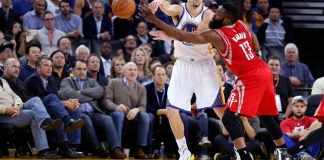The Indiana Pacers are now entering the post-Paul George era, which paints Myles Turner as the new face of the franchise.
Upon trading away Paul George, Kevin Pritchard felt that Victor Oladipo and Domantas Sabonis was the best deal Indiana was going to get. By agreeing, the Pacers appear to be looking toward the future, and that means finding a replacement for George. While Oladipo and Sabonis and dependable players who have the potential to make an impact, Myles Turner is next in line to succeed George as Indiana’s centerpiece.
Turner will begin his third campaign at 21-years-old. He’s the fourth-youngest Pacer behind Sabonis, T.J. Leaf and Ike Anigbogu, but his sophomore campaign was more than enough evidence to show that he can compete with his contemporaries. Turner became Indy’s starting center and, arguably, their second-best player. In 81 games, he set career-highs in every major offensive category: points (14.5), rebounds (7.3), blocks (2.1), assists (1.3) and field goal percentage (51.1).
Turner’s drastic improvement is shocking. While he logged more minutes (31.4 from 22.8), his usage dropped to 19.5 percent, which was the seventh-highest on the Pacers roster and third among those with at least 1,000 minutes. When we talk about efficiency, low-usage players aren’t brought up usually because it’s difficult for them to produce when they don’t have the ball in their hands. However, in Turner’s case, the numbers are eye-catching, and that makes his usage an after thought. Last year, there were five other players to average at least 14 points a night with a usage rate below 20 while playing more than 1,000 minutes: Rudy Gobert, Al Horford, Danilo Gallinari, Gary Harris and T.J. Warren.
Also Read: Myles Turner, T.J. Leaf Could Create Something Special
You can argue either Gobert or Horford as the most impactful, but Turner is slowly creeping into that conversation. His PER (18.5) was second to Rudy’s, and he’s also the second-best defender on that list. Turner’s ability to manufacture offense is what makes him a tough guard and a budding two-way star.
Rookie Myles didn’t have much in his bag. That changed during year two. He became a better finisher around the basket (69.8 from 67.8), slightly more polished in the post and, most importantly, developed a killer three-point stroke. Overall, Turner buried just 34.8 percent of his triples. That, however, rose 13.4 percentage points, and it would’ve been higher if not for horrid inaccuracy from the corners. On straight away threes, Turner connected on 38 percent. He was just 2-of-14 from the short porches.
One of Indiana’s biggest problems last year was putting points on the board. They were average at 105.1 a night, but that was underwhelming given the amount of talent they had. Turner’s breakout is encouraging. Because he expanded his game, the Pacers don’t have to spend as much time searching for what works and what doesn’t. The offense will run through Turner and then branch off once everyone gets acclimated.
As the NBA evolves, the pick-and-roll is the go-to set for every team with a decent point guard. Indiana has Cory Joseph, Darren Collison and Joe Young on the roster for next season, and they’re going to fight for a majority of the minutes at the one, but Turner made another huge leap as the roll man. At 1.03 points per possession, the 21-year-old falls in the 51st percentile, but that’s significantly improved from the 18th percentile as a rookie. He also shot dramatically better, boasting an effective field goal percentage of 52.3, up from 41.4.
Any big who can space the floor is a tough guard for the defense. It’s even more challenging when he’s pushing seven feet, can play in the post and is also athletic enough to pull down alley-oops that defenders can’t get. That’s Myles Turner in a nutshell.
It’s rare to see forwards and centers as a team’s centerpiece because of the point guard renaissance. Turner is one of the few. Given his skill set, I don’t see Indiana changing their philosophy, especially since this year is going to act as a grace period because of George’s departure.
The Pacers were one of the slower teams in the NBA last year; Basketball Reference has their pace at 95.9 possessions a night. They were able to mix it up but were well below-average at scoring when the tempo increased. Turner, oddly enough, had no issues. In fact, he fell into the 91st percentile. All the attributes and skills that work in the halfcourt translate to transition, and, even if Turner doesn’t get something immediately, he’s able to seal off defenders and get deep positioning with his back to the basket.
That’s huge. Turner isn’t the strongest big in the league, but he knows how to seal without overpowering anyone, a skill that all of the all-time great post players had. Of course, those guys needed the moves to put the ball in the basket. Turner has those, but he can also counter when someone takes away his initial look. On top of everything, his ballerina-esque footwork keeps him balanced at all times, and a high release on his jumper makes it nearly impossible to block.
Also Read: Victor Oladipo Can Finally Bloom With Indiana
As dazzling as Turner was on offense, he’s even more of a game-changer on defense. The Pacers trusted him to be their anchor last year, and he didn’t disappoint. Turner’s length and athleticism made him the NBA’s second-best shot blocker, and he held opponents to just 53 percent shooting inside of six feet, per NBA.com. However, it’s easier to gauge someone’s impact by how the team performs when a particular player isn’t on the floor, and the Pacers were 2.9 points per 100 possessions worse when Turner sat; that inflated to minus-7.0 during the playoffs, but the Cavaliers still had an offensive rating of 117.4. (Here’s a fun fact: in Pacers history, only Jermaine O’Neal (6.2) and Roy Hibbert (6.7) blocked a higher percentage of shots in a single season than Turner (5.9) did in 2017.)
Turner also improved as an overall defender. He’s better suited as an anchor, but he joined Giannis Antetokounmpo, Anthony Davis and Draymond Green as the only players this year to have more than 100 rejections and 70 steals, according to Basketball-Reference. That’s very elite company.
As Turner matures, he’s going to become more disciplined. After two years, that’s his biggest issue on defense. He got whistled for 262 personals this year. That averaged out to 3.2 a night, and Basketball Reference estimated that 156 of them were shooting fouls.
It’s going to get dark for the Pacers. Fortunately, Myles Turner is one of the brightest young studs in the league. He plays both ends of the floor with consistent energy and is only going to get better over the next couple of seasons. It took Paul George some time to become the player he is today, and Turner’s first two seasons are statistically better than George’s. Should Turner continue at this pace, there’s no question he’s going to be among the NBA’s elite bigs by the time he’s 25. He’s the complete package and a somewhat underrated unicorn.
Start a conversation with me on Twitter

